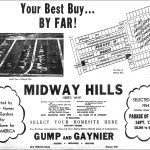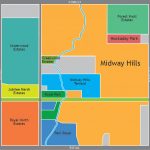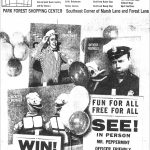The NPNA neighborhood was settled originally as farmland in the mid and late 1800s, by some of the prominent families of early Dallas history. They came as part of the Peter’s Colony, a land grant which recruited settlers with promises of free land in more than 18 counties of present day North Texas.
Thomas C. Williams, whose grant included our one-square mile, came from Tennessee in 1845 with his family. He was one of the first school teachers in Dallas County. His wife, Sarah Hughes Williams, was one of six sisters whose husbands were also involved in the early development of Dallas County – William Cochran, Isaac Webb, O.W. Knight, John Bachman, George Record, and Levi Dennis. In 1856 Mr. Williams sold 480 acres and moved to Cedar Springs. The land changed hands a couple of times until 1878 when the Cox family purchased 189 acres for their farm.
The Cox Home and Dairy
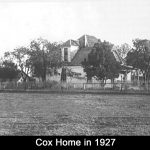 In 1884 – about the time Main Street in Dallas was being lit with electricity – Howard and Mary Jane (Webb) Cox began building their family home at 11210 Cox Lane. They added on as their family grew to 11 children and finally completed the home in the first decade of the 1900s. The farmhouse is characterized as a “Queen Anne Victorian” and contains many of this style’s typical characteristics, like the steeply pitched roof, dominant front-facing gable, and wraparound porch. The earliest portion of the structure (the north side) still sits on its original bois d’arc piers. The balloon frame and ship-lath construction are responsible for its excellent condition. The home stands as a landmark in our neighborhood and holds both City of Dallas and State of Texas historical designations.
In 1884 – about the time Main Street in Dallas was being lit with electricity – Howard and Mary Jane (Webb) Cox began building their family home at 11210 Cox Lane. They added on as their family grew to 11 children and finally completed the home in the first decade of the 1900s. The farmhouse is characterized as a “Queen Anne Victorian” and contains many of this style’s typical characteristics, like the steeply pitched roof, dominant front-facing gable, and wraparound porch. The earliest portion of the structure (the north side) still sits on its original bois d’arc piers. The balloon frame and ship-lath construction are responsible for its excellent condition. The home stands as a landmark in our neighborhood and holds both City of Dallas and State of Texas historical designations.
The home served as a focal point for the community and prominent families of early Dallas society – Cox, Cochran, Webb, Marsh, and Merrell, to name a few. These families gathered to discuss matters of local importance and to socialize. “Family lore” has it that, after merchants along Preston Road complained that cattle being herded to market were disruptive to business, Mr. Cox arranged for them to use Cox Lane instead (for a fee).
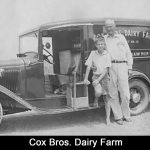 About 1931 two of the sons, Isaac Howard Cox and Joe Cox, established the Cox Brothers Dairy and delivered milk to area residents, including some in Highland Park and University Park. The dairy operated about twenty years until, after consulting with their adult children about their desire to retire from farming, most of the land was sold to developers who would built the ranch and contemporary homes of our neighborhood.
About 1931 two of the sons, Isaac Howard Cox and Joe Cox, established the Cox Brothers Dairy and delivered milk to area residents, including some in Highland Park and University Park. The dairy operated about twenty years until, after consulting with their adult children about their desire to retire from farming, most of the land was sold to developers who would built the ranch and contemporary homes of our neighborhood.
Building the Neighborhood
In the years after World War II, a housing boom stimulated by affordable mortgages and the movement of families away from family farms. Advances in mass production, home appliances, retail shopping centers, and highway construction further fueled the growth of American suburbs.
Our area just north of Dallas was a prime location for expansion and new, affordable homes. In 1954 developers Robert Gump and William Gaynier purchased part of the Cox Brothers farm and began developing Midway Hills. The first homes built were in the southwest corner of the neighborhood where they named the streets after Walt Disney characters and places. Thus, the area became known as the Disney Streets.
The 1954 Parade of Homes, an annual showcase of new homes by the Dallas Association of Home Builders, featured 20 of the homes on Pinocchio between Royal and Humpty Dumpty (now Sleepy Lane). It was quite an affair with spotlights, music, and free movies. The event lasted 2 weeks and drew about 100,000 visitors. It was so successful that the show was repeated in 1955 with 15 homes just north of the previous year’s event. More about the Disney Streets.
In a 1955 news article, the Gump & Guynier firm was toted as a “One Stop Service” where one could have a new home designed, built, financed, Insured and located on a desirable home site. At the same time, the old home would be appraised and put on the market for sale. The Forest & Gump goal was to make this area the most desirable neighborhood in Dallas in which to live and raise a family. They did not stop supporting new residents when the home sale was complete. Instead, they worked to create a community. A monthly newsletter introduced new neighbors, reported on recent developments around the area, and gave hints for working with utility companies. A Spring block party and barbecue was hosted by the firm to further bring families together. Hmmm, sounds a lot like what NPNA does today.
By 1959 Midway Hills was touted as “not too far from downtown, but with a definite suburban atmosphere.” That year Harry C. Withers Elementary opened, most of the Disney Street area was complete, and the first section of homes in Underwood Estates (on Northview west of Cox) was complete. New homes in other subdivisions soon followed. Most homes were complete in all of Northaven Park by the mid-1970s.
The area was annexed by the city of Dallas in 1961, and by 1962 the Park Forest Shopping Center was opened. Our one-square mile was no longer out in the country. In 1960 work had begun to upgrade U. S. 77 (now IH35E) to interstate standards. By 1966 the Dallas North Tollway was open and LBJ (IH635) was under construction.
Parks
Parks were always part of the neighborhood plan. Northaven Park, over two city blocks along Joe’s Creek north of Northaven Park Road was part of the Midway Hills master plan in 1955. The 5-acre Cox Lane Park, east of Cox Lane just north of Royal Lane, was part of Park Royal subdivision plan in 1968. A recent addition is Northaven Trail, a recreational hike and bike trail running along the utility easement south of Northaven Road. It opened in 2019. More about Parks.
Shopping Centers
The grand opening of Park Forest Shopping Village (southeast corner of Forest and Marsh) was held in June 1962. It was three days of prizes, search lights, music, clowns, balloons, free pony rides, and entertainment, including Mickey and Michelle (TV puppets), Charlie & Harrigan (KLIF disc jockeys), Officer Friendly and pal Jimmy Duck, Mr Peppermint, Bill Murphy and the Plaids, and the Fireman’s Band from the Dallas Fire Department. The center boasted 12-foot canopies over all sidewalks, 125,000 square feet of retail shopping, and a medical professional building. Stores included Wyatt Food Store, Skillern’s Drugstore, M.E. Moses, and a variety of small businesses. In 1963 Fed-Mart, a 100,000 square-foot discount department store, opened just across Marsh. This was all before NorthPark Mall (1965), Valley View Mall (1973) and the Galleria (1982).
Park Forest Theater. In July 1965 the Park Forest Theater opened in the Park Forest Shopping Village with a special invitational showing of “Lord Jim” starring Peter O’Toole. It opened to the public the next day with “A Very Special Favor” starring Rock Hudson and Leslie Caron. The theater featured airliner lounge seats that had two seating positions and a seating capacity of 650. The theatre opened as an “adult ticketing only” (17 years and older) with mature audience themes booked for the films, but not porn. It closed as a second-run discount house 18 years later in July 1983. The building was repurposed and now is the home of the Antique Mall.
Schools
As a result of families moving into the area, Dallas needed new schools. Enrollment by the end of the 1960s was expected to be over 200k. Harry C Withers Elementary, named in honor of a retired executive editor of the Dallas Morning News, opened in September 1961 on Northaven Road. The same year, Thomas C Marsh Junior High, named for an early Dallas settler, opened just across Forest on the north side of the neighborhood. High enrollment in area schools did not last. During the 1970s school integration and busing resulted in low enrollment in many DISD schools as students moved to private schools. With only 73 students in 1981, Withers closed. It would reopen in 1990 with 550 students as students began returning to neighborhood schools. It is now one of the top-rated schools in the city.
